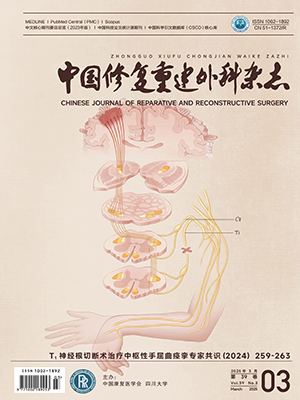Objective To construct a recombinant adenovirus vector containing human vascular endothelial growth factor 165 (hVEGF165) [pAdxsi-enhanced green fluorescent protein (EGFP)-hVEGF165], and to observe the expression of
hVEGF165 by transfecting pAdxsi-EGFP-hVEGF165 into rat bone marrow mesenchymal stem cells (BMSCs) in vitro so as to lay a foundation for further research on gene therapy of blood vessel regeneration. Methods hVEGF165 was l iberated from plasmid and was subcloned into pShuttle-EGFP. The pShuttle-cytomegalo-virus-EGFP was then transferred to pAdxsi vector, by which pAdxsi-EGFP-hVEGF165 virus plasmid was obtained and was identified by enzymes restriction analysis and gene sequencing. The pAdxsi-EGFP-hVEGF165 was l inearized by digestion with restriction endonuclease PacI, and was then transfected into human embryonic kidney cells (HEK293). The retrieved recombinant adenovirus was titrated by using 50% tissue culture infective dose assay. The rat BMSCs were cultured and were infected with recombinant adenovirus containing EGFP (pAdxsi-EGFP). The multipl icities of infection (MOI) of transfection were determined by fluorescent inverted phase contrast microscope and flow cytometry (FCM), by which the most optimal value of MOI was confirmed and was used for transfecting pAdxsi-EGFP-hVEGF165 into BMSCs. The expression of hVEGF165 gene was indentified by performing Western blot, RT-PCR, and ELISA. The effect of transfection on BMSCs prol iferation was assessed by MTT. Results The expression of hVEGF165 cDNA in recombinant adenovirus plasmid was indentified by enzymes restriction analysis and gene sequencing. The titer of virus could be up to 1 ×1010 pfu/mL after several rounds of transfection and ampl ification. The efficiency of transfection on FCM was 88% when MOI being 150 pfu/ cell, at which the most optimal of MOI was achieved, as observed on fluorescence. The expressions of hVEGF165 at both mRNA and protein levels were detected after 48 hours of the transfection. The results of ELISA showed the expression of
hVEGF165 peaked at 7 days, and the production was found even after 20 days. Furthermore, the expression of hVEGF165 protein at 1, 3, 5, 7, 9, 11, 13, 15, and 20 days in the group transfected with pAdxsi-EGFP-hVEGF165 was significantly higher than that in the group transfected with pAdxsi-EGFP and in untransfected group (P lt; 0.05). The results of MTT demonstrated that here was no significant difference in absorbance (A) value between transfected with pAdxsi-EGFP-hVEGF165 group and untransfected group (P gt; 0.05). Conclusion BMSCs are suitable for gene transfection, and hVEGF165 gene can be transferred into BMSCs with high efficiency using pAdxsi-EGFP-hVEGF165 at a MOI of 150 pfu/cell. The transfected BMSCs can highly express hVEGF165, which has no effect on BMSCs growth and prol iferation.
Citation: LIANG Wenjia,CAI Qian,LIU Yi.. TRANSFECTION OF HUMAN VASCULAR ENDOTHELIAL GROWTH FACTOR 165 GENE INTO RAT BONE MARROW MESENCHYMAL STEM CELLS IN VITRO. Chinese Journal of Reparative and Reconstructive Surgery, 2011, 25(11): 1383-1387. doi: Copy
Copyright © the editorial department of Chinese Journal of Reparative and Reconstructive Surgery of West China Medical Publisher. All rights reserved




